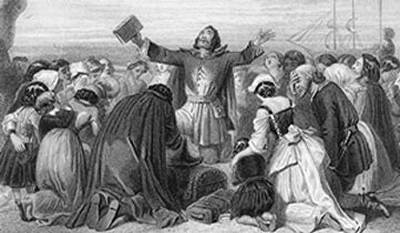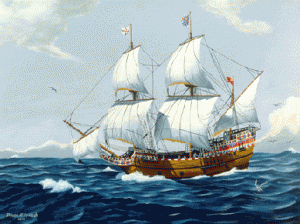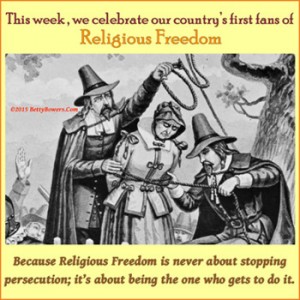Every historical event has at least two sides, and the events leading up to the Thanksgiving holiday are no exception. This particular year, with all the excitement over Syrian refugees, some of the darker elements of Thanksgiving have been brought to center stage.
This meme has been popping up around the Internet all week:
The implication of this is religious freedom is less about freedom from persecution and more about the freedom to persecute. And by extension the Pilgrims – the gang that came over on the Mayflower – were a bunch of whack jobs who came to North America so they could practice their own form of religious persecution. As a historian, I am compelled to point out that this is not true. Mostly.
The Pilgrims had the worst luck.
The Pilgrims were rather like the Amish or Mennonites are today. They wanted to be left alone to practice their version of Christianity, and weren’t that interested in what the rest of the world was doing. The congregation took form in the southern part of Yorkshire, specifically the shire of Scrooby, around 1600. They had drifted from the Church of England to the point where they had broken away. But unlike many other groups of the time, they weren’t interested in reforming the whole of England. They just wanted to be left alone. By and large, the English government granted their wish, probably because they weren’t worth fussing over. The local government and the communities in Scrooby, however, harassed them no end. This became an unfortunate pattern for them.
The convictions of the Pilgrims would not allow them to swear loyalty to any king or civil authority, so were always in trouble with the powers that be, on some level. In 1607, the group relocated to Holland, hoping to fare better there. At the time, Holland had a very open view of religious practice, where any form of Protestant faith was accepted, so long as they didn’t cause local problems. This looked like a solution.
Unfortunately, Dutch society didn’t suit them. The Pilgrims were a largely rural minded people, while the Dutch were far more cosmopolitan and urban. The children of Pilgrims were frequently “going native” among the Dutch, and even married into local families. The biggest problem came when Spain began to exert more control over Holland. This would have ended the Dutch “open door” policy on Protestant faiths, and would have isolated the Pilgrims. So, they went back to England to search for another solution.
Before I continue, remember that this was the seventeenth century. The Reformation had just taken place, so European civilization was undergoing a lot of changes. In fact, the Protestant Reformation was one of the prime motivations for colonizing the Americas. The events leading up to the colonial era won’t make much sense unless you study the Reformation first.
The Pilgrims followed a form of Christianity that drew heavily on Calvinist doctrines, which was inherently rigid and slow to accept new ideas. As with any group, some practitioners are more zealous than others. Internally, the Pilgrims were rather strict, but when dealing with the outside world they were fairly lenient. I suspect they figured that the rest of the world would come around eventually, so why make trouble?
Anyway, the fledgling Virginia colony eventually caught their attention, and the Pilgrims started making plans to make a fresh start in the New World. This didn’t go exactly the way they wanted it to. The whole process was troubled by financial problems, and a cast of shady characters. Originally they were to leave for Virginia in April of 1620. They ended up leaving in August, and instead of using two ships, they were crammed into one, the famous Mayflower. And instead of getting a charter for land in the Chesapeake region, they received land much further north.
Note that the Mayflower was not designed to transport passengers, and it wasn’t suited for a transatlantic voyage. It was designed for short cargo trips around the North Sea and along the coast of Europe. The 26 day voyage was a difficult one. Several members of the Plymouth Company, back in England, expected the Mayflower to sink en route, and some were hoping for an insurance payout in such an event. But the ship did make it, and landed in what became Plymouth, on the coast of Cape Cod bay.
Also, the preferred target site was in the Hudson Valley, but the winter storms in the Long Island Sound would have made such a trip exceedingly dangerous, and these people had been through enough already. Given their arrival date, the most sensible choice would have been to turn north, to the French outpost of Port Royal in Nova Scotia. However, there was no way in the world that the Pilgrims were going to spend the winter with a bunch of French Catholics! So, Plymouth it was.
Since they arrived in late fall, it was impossible for the Pilgrims to set up a fall crop. As a result, during that first winter, roughly a third of the Pilgrims died. Merry Christmas.
Still, by the fall of 1621 the colony had settled into a more or less stable routine. When the Pilgrims founded Plymouth, their prime motivation was to have a place where they could practice their faith undisturbed. And that’s exactly what they did. At first.
The Plymouth colony had problems from the start. The colony was expected to produced a certain quota of cash crops and other goods within a growing season. However, the schedule in use was based on Jamestown and other locations in Virginia. The growing season in Massachusetts is much shorter than that of Virginia, so Plymouth was constantly playing “catch up” on their yields. It wasn’t until a few years later that someone suggested altering the schedules to reflect this. (What a concept…) Also, various members of the colony had taken to shady business practices, largely for their own gain, which left the Plymouth Company (back in England) constantly mired in legal problems. Worst of all, supply ships from England were few and far between, and rarely provided the men and materials that Plymouth really needed.

Image credit: Geoff Mangum’s guide to Native American history and culture.
What about the Natives?
This part of the Pilgrim story has been romanticized to the point of absurdity, and the revisionist accounts aren’t any better. The Pilgrims had very little contact with the locals, and it was for the worst possible reason. A large portion of the local population died in a smallpox epidemic, shortly before the Pilgrims arrived.
In all likelihood, the smallpox came via European surveyors, explorers and trappers, who worked in the region before the Pilgrims. These people probably didn’t know they were carriers of smallpox. (The use of smallpox as a chemical weapon against the Natives wasn’t practiced until the 1800’s.)
Some of the remaining natives did trade with the Pilgrims, and it was from these that the Pilgrims learned which crops and game worked in the New World, and which ones didn’t. All in all, the Pilgrims and the Natives generally left one another alone. The Natives didn’t see the Pilgrims as a major threat, and the Pilgrims knew better than the anger the one group that knew the area, so an uneasy truce existed. So there actually is some truth to the stories of the Pilgrims and Natives having a giant harvest party.
Some of the more unscrupulous members of the colony made trouble for both the Natives and other Pilgrims. The Plymouth company in England also had legal and economic problems of nearly every type. There was even a case of a group of trappers selling firearms to the Natives, and generally living like happy-go-lucky heathens up and down Cape Cod. To make a long story short, the charter of the Plymouth colony ceased to be viable, the company was ripe for a takeover, and absorption of the Plymouth colony by another colony was inevitable.

Image credit: EndTimePilgrim.org
The real bad guys.
While the Pilgrims were largely a peaceful lot, they had problems. Since they no longer had to contend with external political forces, at least not consistently, human nature kicked in and many of the Pilgrims started acting in much the same way as their former oppressors. That is to say, they became increasingly less tolerant of people who weren’t part of their congregation. The Plymouth colony was absorbed into a new colony charter, the Massachusetts Bay charter, in 1629. And the colony had become fertile ground for a new form of madness, especially when a highly successful group moved in.
This group was the Puritans. If you want to know who the real troublemakers were during this phase of American history, look no further than these guys. Many history books end the story of the Pilgrims before Plymouth started changing, and jump straight to the Puritans. Leaving out the changes in Plymouth during the interim is a lie of omission.
When this zealous group arrived and founded what would later become Boston and New Haven, things really got crazy. Even the Natives noticed the threat they posed. Unlike the Pilgrims, who believed that others would join them in time, the Puritans went on the offensive. They were extremely phobic of any religious sect except their own, and felt it was their sacred duty to “save” people from other “false” or “impure” religions. The Puritans seriously believed that by forcing conversions, they were helping people! Rather like forcing a child to take bad-tasting medicine.
“This is for your own good…”
Their colony grew quickly and prospered, but not without incident. There were several skirmishes with other groups, mostly over religion. One of the most famous of these was in Maryland. Maryland was set up to be a largely Catholic settlement. The Puritans exercised a loophole in the charter to found the city of Annapolis, specifically to create an enclave in the largely Catholic colony, with the long range goal of breaking it apart. Scariest of all, they never tried to hide this agenda. The Puritans were a scary bunch.
Even so, I have to be fair and acknowledge the role the Puritans have played in American history. Their zeal, drive, and work ethic has had a tremendous influence on the development of the United States, and it can not be ignored. The pragmatic determination and “can do” attitude that has long been part of the American character can largely be traced to the Puritans. It can be argued that in the long run they did more good than harm, but even now, 400 years later, that is still a subject of debate.
Regardless, they were not nice people. They went after the pacifist Quakers, for crying out loud! Their particular form of religious xenophobia can still be found in many parts of modern America. A lot of the “right wing nut job” attitudes can trace their origin to the Puritans.
Another thing to consider is that there are, especially in the modern world, religious groups within the United States who define themselves by who they hate. This attitude can also be traced to the Puritans. When someone comes up to one of these groups and says “you have to stop persecuting Group X,” they respond with “you are violating my freedom of religion,” because the hatred of Group X is their religion. Telling them to stop hating is equal to telling them to abandoning one of their core beliefs. In cases like these, I’m tempted to tell them tough cookies, but the problem remains.
I’ve long maintained that if you scratch any organized religion deep enough you will find the notion of “I am right, you are wrong, and you must conform to me.” Some religions, like the Puritan version of Calvinism, doesn’t need to be scratched very deep at all.
And again, what about the Natives?
The plight of the Native American is an ugly one, and on the whole, the Native American has had a rough deal. I don’t know what more can be done about it at this point in time. One sad thing to consider is what happens when two different levels of technology come into contact with one another. The lower tech level always gets trounced. History is very unforgiving on this point. It has happened many times in the past, and it’s likely to happen again.
As an aside, I have some Laurentian Mohawk far back in my own lineage, on my mother’s French-Canadian side. I sometimes wonder how my own past might have changed if certain historical events had turned out differently.
In conclusion…
OK, the Pilgrims were a weird bunch. They were isolationist, and very territorial about their little enclave. But on the whole they were just a bunch of people who wanted to build a new life, like most immigrants and refugees. Comparing them to persecutors isn’t fair.
But if you really want to single out some villains from this time period, at least in this region of America, the Puritans are a good candidate. But you must take into account the influence that they had on American history as a whole. And after you have considered the implications of that, go take an aspirin. You’ll probably want one.
Most of my historical information came from one of my old textbooks:
It’s an older textbook, but it’s very well researched, and has held up well. Part of this is because Hawke went out of his way to keep modern biases out of his narrative, and to present things as they were seen as the time. Ignoring a contemporary mindset and attempting to take on that of another time is not an easy task, but to truly understand history, one needs to try.


